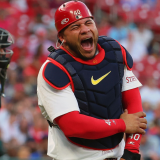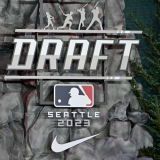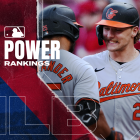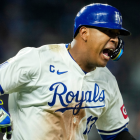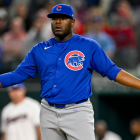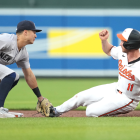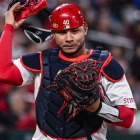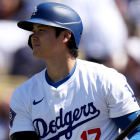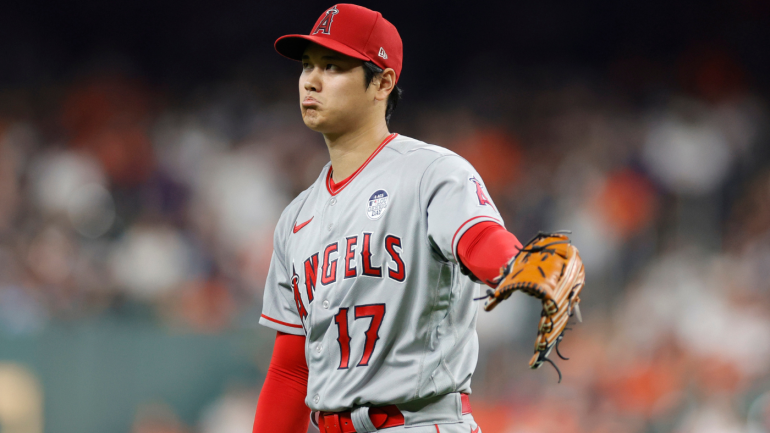
The 2023 MLB season is more than two months complete and we are now closer to the trade deadline (Aug. 1) than we are to Opening Day (March 30). The All-Star Game at Seattle's T-Mobile Park is only five weeks away, if you can believe that. Fan voting for the All-Star Game starters is now open.
Our bi-weekly series breaking down various trends across the league continues Wednesday with a star pitcher's overused pitch, one team's juggernaut offense, and another club's issues with the bases loaded. Last week we looked at Ronald Acuña Jr.'s first inning dominance, the Rays' shaky bullpen, and Chris Sale's pre-injury velocity spike.
Ohtani's possibly overused sweeper
Although he remains as productive as ever at the plate, Los Angeles Angels two-way star Shohei Ohtani has taken a step back on the mound this season, not that he's been bad. Ohtani leads baseball with a .174 opponent's batting average and ranks second with a 33.8% strikeout rate. His "down" year on the mound features a 3.30 ERA and a 1.01 WHIP, which is still excellent.
Ohtani's control has taken a step back, however. His 10.2% walk rate is seventh highest in baseball and considerably higher than last season's 6.7% mark, plus he leads baseball in both hit batters (eight) and wild pitches (10). Ohtani threw 14 wild pitches all last year, and he hit 12 batters total from 2021-22. He's on pace to set new career highs in each category by a lot.
Home runs have also been a recent bugaboo. After surrendering homers to Yordan Alvarez and Corey Julks in his most recent start, Ohtani is up to 10 home runs allowed in his last seven starts and 40 innings. That comes after a 79-inning stretch in which he did not allow a homer. Six of those 10 homers have come off Ohtani's slider, which is a sweeper with a huge spin rate and a ton of horizontal movement. It is his most used pitch:
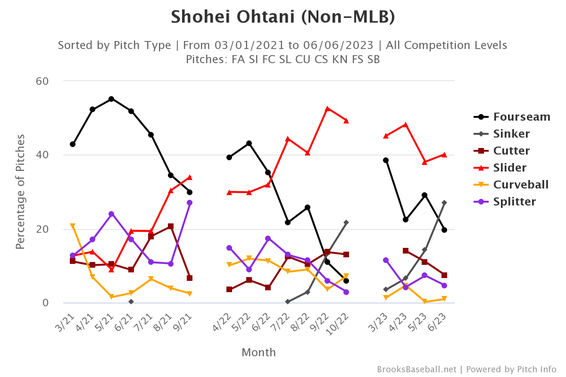
On one hand, it makes sense Ohtani has allowed the most home runs on his most-used pitch. On the other hand, the six home runs against the sweeping slider in those last seven starts equal the number of homers Ohtani allowed on the sweeper all last season, and are two more than he allowed on the pitch in 2021. The sweeper, Ohtani's best pitch, is being taken deep more often.
"For the most part I'm satisfied with the shape and how it's moving, but I missed some spots here and there," Ohtani told the Orange Country Register about his sweeper following his last start.
Look at the six homers Ohtani has allowed on the sweeper. As effective as the pitch is overall, when you leave it over the middle of the plate like this, yeah, hitters will do damage:
Ohtani has thrown his sweeper 41.9% of the time this season, far and away the highest rate of sweepers among starting pitchers (Yankees righty Clarke Schmidt is second at 29.3%). Opponents are hitting .159 with a 37.6% whiff rate against Ohtani's sweeper, which is outstanding, but when they make contact, they've done damage (seven singles and 11 extra-base hits against the pitch).
Sweepers are very effective at generating weak contact and swings and misses -- there's a reason they've become so popular around the league -- though the pitch is not without its flaws. It's difficult to throw for strikes because it moves so much, and, as FanGraphs showed last year, it has a platoon split. It is less effective against batters on the opposite side of the plate.
As effective as the sweeper is and has been for Ohtani, it's entirely possible he's throwing the pitch too much, as recently discussed on the Effectively Wild podcast. Ohtani may have reached the point of diminishing returns, where the sweeper is no longer effective as it once was because of overexposure. It happens in this game and adjustments have to be made.
Ohtani certainly doesn't lack weapons. He still lives in the upper-90s with his fastball, he successfully added a sinker last season, and his splitter has been a top of the line swing-and-miss pitch throughout his career. Scaling back on the sweeper a bit, and replacing it with a few more fastballs and splitters, could be the solution if Ohtani's control and home run problems linger.
The Rangers' 1,000-run pace
After two offseasons of significant free agent spending, it is not too surprising to see the Rangers atop the AL West with baseball's second-best record. Ownership and the front office invested heavily in the roster and now that roster is rewarding them with stellar play. They have the franchise's best record ever through 60 games, including the Washington Senators years.
The way the Rangers are dominating is perhaps unexpected. They spent a lot -- A LOT -- on this pitching this past offseason and they entered play Tuesday ranked third in ERA (3.62) and third in pitching WAR (8.3), so the run prevention has certainly been great. The offense has been out of this world good, however. Some fun facts about the Texas offense:
- The Rangers are averaging 6.44 runs per game, easily the most in baseball. The Rays are second at 5.79.
- They lead baseball with a .278 team batting average. The Rays are again second, way down at .266.
- Texas also leads baseball in on-base percentage (.345) and is third in slugging percentage (.460).
- The Rangers have scored 10-plus runs 18 times this year. No other team has done it more than eight times.
- They've had a lead of at least 10 runs in 11 different games. That is just absurd.
- The Rangers are hitting an incredible .377/.384/.554 with runners in scoring position.
"I think it just comes down to trusting in the guy behind you. You can go out there and put up a good at-bat, and even if you don't get the job done, you have confidence in the guy behind you're gonna get the job done," catcher Jonah Heim told MLB.com recently. "So I think guys are going up there with a good approach and swinging at pitches that they can do damage on and not chasing, and guys have taken our walks and it leads to big innings. I think it just comes down to trusting the guy in front of you or behind you to put together good at-bats."
The last team to score 380 runs through their first 59 games before this year's Rangers was Cleveland in 1999, when they scored 392 runs through 59 games. The 1998 Yankees scored 381 runs in their first 59 games -- they had an expansion team in their division, remember -- and before them, the last team to hit that marker was the 1950 Red Sox (409). Texas is on pace to score 1,043 runs this season, which would make them only the fourth 1,000-run offense in history. The first three:
- 1936 Yankees: 1,065 runs (155-game season)
- 1999 Cleveland: 1,009 runs (162-game season)
- 1932 Yankees: 1,002 runs (156-game season)
Will the Rangers continue on a 1,000-run pace? Almost certainly not. It's only happened three times in history and only once in the last 85 years. Scoring that many runs is really, really hard, and I would bet the under on the Rangers getting there. That said, they have as good a chance to score 900 runs as any team since 2019, when three teams got there in the Year of the Home Run.
Texas invested heavily in Marcus Semien and Corey Seager, who, to date, look like the wisest investments of the last two shortstop free agent classes. Josh Jung is the AL Rookie of the Year frontrunner, Ezequiel Duran and Leody Taveras are having breakout seasons, Heim is emerging as a top tier catcher, and others like Nathaniel Lowe and Adolis García have been steady. The lineup is deep with contact ability and power potential throughout. Through two months, the Rangers have baseball's best offense in years.
"We still haven't even shown our full potential yet," Semien told the Dallas Morning News recently. "So it's going to be fun to get to the summer."
The Twins' futility with the bases loaded
Although they currently reside in first place in the AL Central, the Twins have not been a powerhouse this season, and their offense in particular has been less than great. They are middle of the pack in runs scored and in the bottom half of the league in batting average, on-base percentage, slugging percentage, OPS, and OPS+. It's been a middling offense two months into the season.
Minnesota's offense has been most futile with the bases loaded, a situation that theoretically puts all the pressure on the pitcher. Look how bad the Twins have been with the sacks full this year:
| AVG/OBP/SLG | OPS+ | BB% | K% | |
|---|---|---|---|---|
Twins with bases loaded | .140/.183/.160 | -3 (!) | 6.7% | 26.7% |
MLB average with bases loaded | .260/.305/.440 | 100 | 7.3% | 23.9% |
The Twins were one of six teams without a grand slam this season entering play Tuesday, and that 26.7% strikeout rate is seventh highest among the 30 teams. The MLB-best Rays are just ahead of the Twins at 27.4%, though Tampa is hitting .340 as a team with the bases loaded, not .140 like Minnesota. You can strike out a lot and still be productive. The Twins aren't though.
In theory, the pressure is all on the pitcher with the bases loaded. He has no margin of error and must attack, while the hitter can be picky early in the count and look for something he can really drive. The Twins haven't gotten the memo, it seems. With the bases loaded, they've swung at 40.0% of pitches outside the zone. They have a 29.2% chase rate in all other situations.
"We were getting close in those situations. We missed a lot of opportunities to get runs," Donovan Solano told the Star Tribune earlier this month about the team's trouble with the bases loaded. "But we can't think about it. We can't make more pressure on us. We as a team need to take those at-bats like normal at-bats."
It must be noted we're talking about a tiny sample here. Entering play Tuesday, the Twins had 60 plate appearances with the bases loaded this season, and that's a relatively big number. Only six teams had more. But still, it's 60 plate appearances spread across 60 games. A couple bloops fall in here and there and the narrative is very different.
At some point someone on the Twins will get The Big Hit with the bases loaded and everyone will relax a bit, and they'll have that collective breakthrough. Or maybe not. Maybe they'll struggle with the bases loaded all year. It happens. The Twins hanging in first place without capitalizing on bases loaded opportunities says as much about the rest of the AL Central as it does the quality of the rest of the team. You can waste these prime run-scoring chances only so long before it really bites you.














